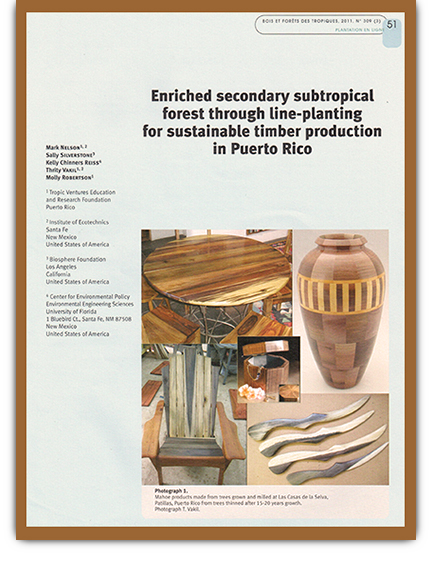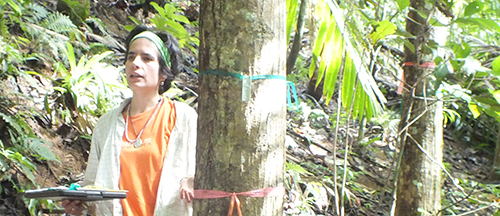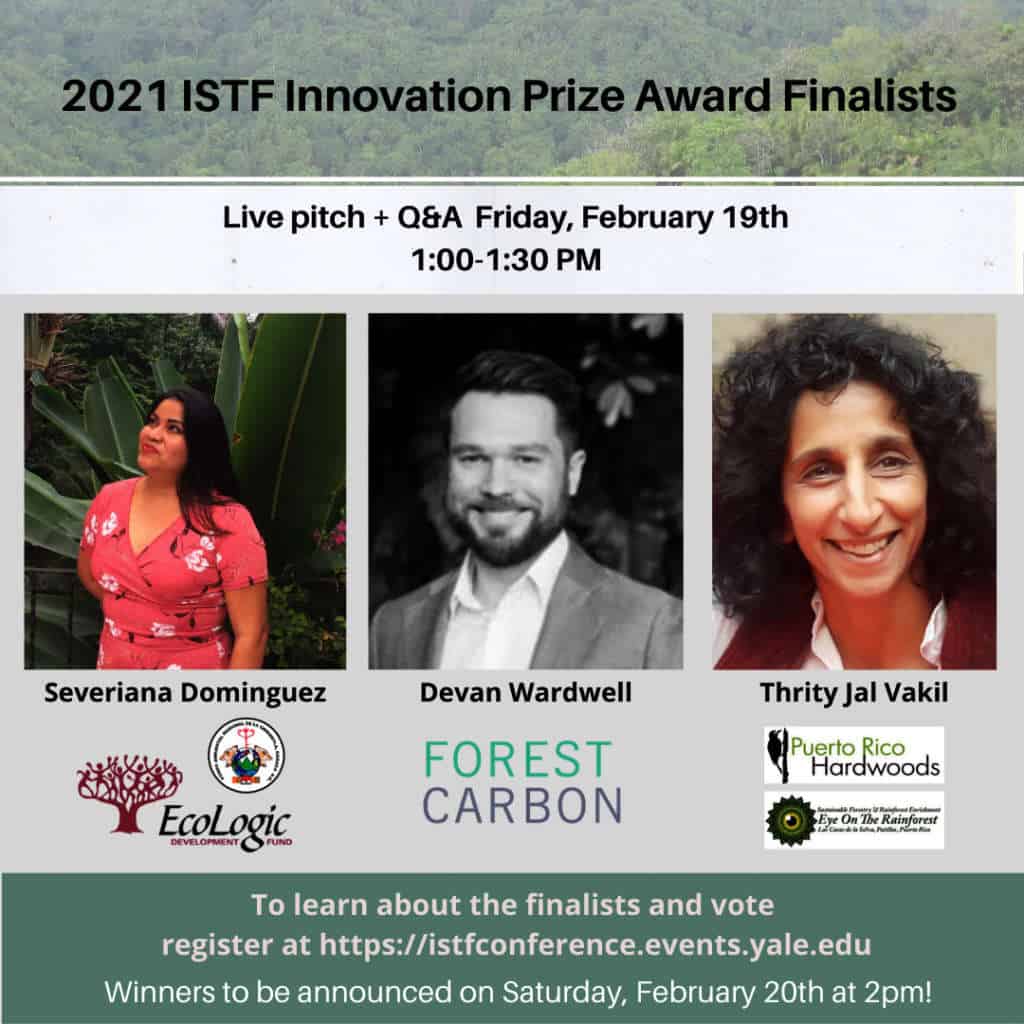
NELSON MARK, SILVERSTONE SALLY, REISS KELLY, ROBERTSON MOLLY, VAKIL THRITY, 2011. Enriched secondary subtropical forest through line-planting for sustainable timber production in Puerto Rico. Bois et Forets des Tropiques, #309 (3): 51-61]
http://Bois et Forets des Tropiques 65(309)
SUMMARY
1984: In general the plantation design was to plant at approximately 3m (10 ft) spacing within the lines and 10m (32.5 ft) from line to line through the forest. In the process of line planting, larger trees and valuable native timber species were left in place and the lines continued with a gap left around them. This technique closely mimics a medium-sized tree fall gap, in which the forest floor litter and soils are undisturbed, but the above ground nearby competition is removed, such as vines and overhanging branches.
2000-2008 19 study plots, 1 acre (0.4 hectare) in size 16 plots of mahogany 3 plots of mahoe. 997 trees studied. Complete sets of reading taken twice. Range 24 to 42 mths between readings.
SURVIVAL RATE Mahogany plantings – 28% approx (dependent on plot aspect- see results, sw best) Initial planting approx. 370 trees per hectare (148 trees per acre) Mahoe plantings – 66%. Initial planting approx. 415 trees per hectare (166 trees per acre) DBH Mahogany trees are increasing in dbh by an average of 0.6 cm per year Mahoe are increasing by an average of 0.91 cm per year. HEIGHT since planting: Mahogany has grown in height at a rate of approximately half a meter per year. Mahoe at a rate of approximately one meter per year.
INDICATIONS The growth data indicate the Mahoe plantation has been far more successful than the mahogany in terms of wood production. At current rates of increase it would take the mahogany at Las Casas another 27 years to get 30 cm dbh trunks for logging, giving a total time from planting to harvest of 43 years. It is currently possible to harvest marketable wood from the mahoe at 15 years. Current conservative estimates for standing marketable wood for mahoe are approximately 58 cubic meters per hectare (25,000 board feet per hectare or 10,000 bd ft per acre). This makes the Mahoe a good candidate for sustainable forestry management where the aim is to get the trees on a cycle of harvesting and replanting to provide a continuous income. A final evaluation of this line planting method as a model for sustainable forestry will be possible when trees are being annually harvested selectively, replanting begins, and the wood and products successfully sold for profit. Future challenges with the Mahoe plantations will involve working out the best thinning and replanting strategies, (and dealing with issues of extraction on slopes, drying techniques, and forest road and bridge repairs after nearly thirty years and two hurricanes). The challenge is on.

Ongoing research on the Mahoe plantation: 2010 – 2012
Jimena Forero is pursuing a Ph.D. Degree at the University of Puerto Rico, Rio Piedras campus. As part of her dissertation she is describing the stand density and the canopy structure of our mahoe enrichment plantation in order to make recommendations for its management. Using our three 1-acre permanent mahoe plots, she has, with the help of undergraduates and Earth Watch volunteers conducted a forest inventory over two years (2010-2012) of these plots at Las Casas de la Selva. Her academic supervisor is Dr. Jess K. Zimmerman, Environmental Sciences professor at the University of Puerto Rico, Rio Piedras. Another part of her dissertation involves interviewing artisans all over the island, who use forest products.
“A narrow size diameter class model for tree growth and yield simulation in a mahoe (Talipariti elatum SW.) Fryxell, Malvaceae) plantation in Puerto Rico”. Jimena Forero Montaña1*, Jess K. Zimmerman2, Thrity Vakil3, , Mark Nelson3,4, Marìa Eglee Perez5, Joaquin Medin6
https://journals-crea.4science.it/index.php/asr/article/view/1850/pdf_1

http://ecotechnics.edu/wp-content/uploads/2011/08/Journal-of-Sustainable-Forestry-Impact-of-Line-planting-on-biodiversity.pdf
NELSON MARK, SILVERSTONE SALLY, REISS KELLY, BURROWES PATRICIA, JOGLAR RAFAEL, ROBERTSON MOLLY, VAKIL THRITY, 2010. The impact of Hardwood Line-Planting on Tree and Amphibian Diversity in a Secondary Subtropical Wet Forest of Southeast Puerto Rico. Journal of Sustainable Forestry, 29(5): 503-516.
SUMMARY
2000-2004 Amphibians: Amphibians are especially useful as biological monitors of environmental health (Wake, 1991). Because in Puerto Rico frogs are the most important vertebrate nocturnal carnivores, a change in their population dynamics could have an important effect on the forest food web (Joglar, 1998). Thus, monitoring amphibians at Las Casas de la Selva was a suitable way to assess the impact of a line-planting forestry approach to tropical forest ecosystems. The main difference between the studied forested areas was that one had been disturbed to plant trees of potential economic value (line-planting), while the other area had been left undisturbed. There was no difference in species composition between the two areas studied. Eleutherodactylus coqui and E. wightmanae are the two most common species in both forests, with occasional sightings of E. portoricensis.
We were happy to note:
Analysis of variance (ANOVA) of mean relative abundance of the two most common species revealed no significant difference between forests.
This is encouraging data.
These results suggest that the degree of disturbance caused by planting economically valuable trees had no effect on amphibian diversity or density in Patillas, Puerto Rico. At a time when the impact of anthropogenic activities on amphibian populations are being evaluated (Stuart et al., 2005), it is important to show that the type of forestry enrichment practiced at “Las Casas de La Selva”, did not have a negative impact on frog abundance. Our work in Las Casas de la Selva is the first record of population densities of E. coqui in the central cordillera of Puerto Rico, and the first record of population densities for E. wightmanae.
At a time when amphibian populations are declining all over the globe, and populations of these two species are declining at El Yunque, these data from Patillas represent a very valuable baseline that will allow us to monitor population fluctuations and potential declines associated to climate change or disease. Chytrid fungus Since June 2004, various species of frogs at Las Casas de la Selva have been sampled for the incidence of a pathogenic chytrid fungus, Batrachochytrium dendrobatidis (Bd). This fungus is specific to amphibians and has been associated to their decline in various parts of the world (Longcore, 1999), including Puerto Rico (Burrowes et al. 2004). Tissue is taken from toe clippings and/or ventral skin scrapes, and analyzed for the chytrid DNA via specific PCR diagnostic methods. Results show the presence of chytrids in Patillas as early as 2005. At present, the level of incidence of Bd infection in Eleutherodactylus coqui is of 50 % and in E. wightmanae is 44 %. Biodiversity of Trees: Overall the line-planting program has resulted in a small increase in the overall diversity of tree species in those areas. See the results in the full paper, link above.
COMING SOON: Jump into our current world of frogs, snakes, lizards and more with Norman Greenhawk, who has been carrying out herpetological surveys in the forests of Las Casas de la Selva for the last five years.

Three ISTF Innovation Award finalists were selected to present their exceptional approaches, experiences or efforts relating to the 2021 ISTF Conference theme: “Timelines and Critical Junctures: Re-examining Crises as Opportunities for Change.”
3t’s virtual presentation told the story of Las Casas de la Selva, Puerto Rico Hardwoods, and the Institute of Ecotechnics, representing all her colleagues and friends that have been involved for decades with these long-term environmental projects. Her award-winning presentation was entitled: “Re-examining Crises as Opportunities for Change: Sustainable Forestry, Log Salvage, & Hardwood production after extreme social, ecological and technological disturbances in Puerto Rico” (See the Video)

Ongoing Coqui frog research at Las Casas de la Selva: 2010 – 2012 Patricia Caligari (center) is pursuing a Masters Degree at the University of Puerto Rico, and as part of her thesis is sampling for chytrid in three species of endemic frogs in different parts of Puerto Rico, including Las Casas de la Selva. Her crew of undergraduate students help in the field and lab with DNA extraction. Her advisor is Dr. Patricia Burrowes, co-author of our paper above. More info
All studies are a building block in the more complex strategy of developing techniques to both satisfying human needs and conserving the resource base.” Ariel Lugo

